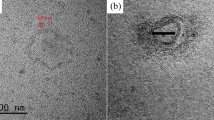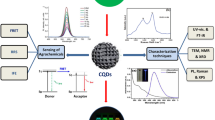Abstract
Aflatoxins form a class of potent carcinogens that contaminate a wide range of food products and can be fatal to humans and livestock. We have designed cysteamine-capped CdS quantum dots (QDs) to serve as aflatoxin photodetectors for use in agricultural industries. Water-soluble CdS QDs are synthesized through growth in a poly(vinyl alcohol) matrix using a chemical precipitation method. The prepared QDs are then characterized with X-ray diffraction (XRD), Fourier transform infrared spectroscopy (FT-IR), dynamic light scattering (DLS), and transmission electron microscopy (TEM) analyses. The obtained results revealed that these CdS QDs have a 1- to 2-nm crystalline size, hexagonal wurtzite structure, and spherical morphology with a diameter less than 10 nm. Photoluminescence spectroscopy (PL) is performed to study the CdS QDs interactions with a standard solution of aflatoxins (B1, B2, G1, and G2 in a ratio of 5:1:5:1) in order to determine their effectiveness as aflatoxin detectors. A green emission peak is observed at 508 nm, with an intensity enhancement positively correlated with total aflatoxin concentration. The lower limit of detection for total aflatoxin concentration is found to be 0.05 ppb, well below international contamination allowances for food products. PL variations with aflatoxin concentration are best described by a Langmuir-type equation in the concentration range of this study (2.4–48 ppb).








Similar content being viewed by others
References
Chiewchan N, Mujumdar AS, Devahastin S (2015) Application of drying technology to control aflatoxins in foods and feeds: a review. Dry Technol 33(14):1700–7
Colak H, Hampikyan H, Ulusoy B, Ergun O (2006) Comparison of a competitive ELISA with an HPLC method for the determination of aflatoxin M1 in Turkish white, Kasar and Tulum cheeses. Eur Food Res Technol 223(6):719–23
Trucksess MW, Stack ME, Nesheim S, Albert RH, Romer TR (1993) Multifunctional column coupled with liquid chromatography for determination of aflatoxins B1, B2, G1, and G2 in corn, almonds, Brazil nuts, peanuts, and pistachio nuts: collaborative study. J AOAC Int 77(6):1512–21
Vandercammen G. New EU aflatoxin levels and sampling plan. USDA Foreign Agricultural Service. Global Agricultural Information Network: 2010 Contract No.: E50018.
Van Egmond H, Jonker M. Worldwide regulations for mycotoxins in food and feed in 2003: Food and Agriculture Organization of the United Nations; 2004
Zekavati R, Safi S, Hashemi SJ, Rahmani-Cherati T, Tabatabaei M, Mohsenifar A et al (2013) Highly sensitive FRET-based fluorescence immunoassay for aflatoxin B1 using cadmium telluride quantum dots. Microchim Acta 180(13–14):1217–23
Sameie H, Salimi R, Alvani AS, Sarabi A, Moztarzadeh F, Tahriri M (2010) Evaluation of sol–gel derived Eu 2+ activated SrMgAl 2SiO 7 as a novel nanostructure luminescent pigment. Phys B Condens Matter 405(23):4796–800
Bodaghi M, Mirhabibi A, Tahriri M, Zolfonoon H, Karimi M (2009) Mechanochemical assisted synthesis and powder characteristics of nanostructure ceramic of α-Al2O3 at room temperature. Mater Sci Eng B 162(3):155–61
Bodaghi M, Zolfonoon H, Tahriri M, Karimi M (2009) Synthesis and characterization of nanocrystalline α-Al2O3 using Al and Fe2O3 (hematite) through mechanical alloying. Solid State Sci 11(2):496–500
Tahriri M, Moztarzadeh F (2014) Preparation, characterization, and in vitro biological evaluation of PLGA/nano-fluorohydroxyapatite (FHA) microsphere-sintered scaffolds for biomedical applications. Appl Biochem Biotechnol 172(5):2465–79
Khosroshahi ME, Ghazanfari L, Tahriri M (2011) Characterisation of binary (Fe3O4/SiO2) biocompatible nanocomposites as magnetic fluid. J Exp Nanosci 6(6):580–95
Salimi R, Sameie H, Alvani AS, Sarabi A, Mohammadloo HE, Nargesian F et al (2013) SrZn 2 Si 2 O 7: Eu 2+, Mn 2+: a single-phased emission tunable nanophosphor suitable for white light emitting diodes. JOSA B 30(6):1747–54
Salimi R, Sameie H, Alvani AS, Sarabi A, Moztarzadeh F, Mohammadloo HE et al (2012) Sol–gel synthesis, structural and optical characteristics of Sr1− x Zn2Si2yO7+ δ: xEu2+ as a potential nanocrystalline phosphor for near-ultraviolet white light-emitting diodes. J Mater Sci 47(6):2658–64
Salimi R, Sameie H, Sabbagh Alvani A, Sarabi A, Moztarzadeh F, Tahriri M (2011) Sol–gel synthesis, characterization and luminescence properties of SrMgAl2SiO7: Eu2+ as a novel nanocrystalline phosphor. Luminescence 26(6):449–55
Shafia E, Aghaei A, Davarpanah A, Bodaghi M, Tahriri M, Alavi S (2011) Synthesis and characterization of SrAl2O4: Eu2+, Dy3+ nanocrystalline phosphorescent pigments. Transactions of the Indian Ceramic Society 70(2):71–7
Bodaghi M, Mirhabibi A, Zolfonoon H, Salehie M, Tahriri M (2008) Preparation and characterisation of α-Al2O3 powder from γ-Al2O3 powder using mechanical milling technique. Mater Res Innov 12(4):157–61
Shafia E, Aghaei A, Bodaghi M, Tahriri M (2011) Combusion synthesis, structural and photo-physical characteristics of Eu2+ and Dy3+ co-doped SrAl2O4 phosphor nanopowders. J Mater Sci Mater Electron 22(8):1136–42
Mohagheghpour E, Moztarzadeh F, Rabiee M, Tahriri M, Ashuri M, Sameie H et al (2012) Micro-emulsion synthesis, surface modification, and photophysical properties of nanocrystals for biomolecular recognition. IEEE Transac NanoBioscience 11(4):317–23
Eslami H, Solati-Hashjin M, Tahriri M (2008) Synthesis and characterization of nanocrystalline fluorinated hydroxyapatite powder by modified wet-chemical process. J Ceram Process Res 9:224–9
Mozafari M, Moztarzadeh F, Tahriri M (2011) Green synthesis and characterisation of spherical PbS luminescent micro-and nanoparticles via wet chemical technique. Adv Appl Ceram 110(1):30–4
Karimi M, Rabiee M, Moztarzadeh F, Bodaghi M, Tahriri M (2009) Ammonia-free method for synthesis of CdS nanocrystalline thin films through chemical bath deposition technique. Solid State Commun 149(41):1765–8
Tahriri M, Solati-Hashjin M, Eslami H (2008) Synthesis and characterization of hydroxyapatite nanocrystals via chemical precipitation technique. Iranian Journal of Pharmaceutical Sciences 4(2):127–34
Shafia E, Bodaghi M, Tahriri M (2010) The influence of some processing conditions on host crystal structure and phosphorescence properties of SrAl 2 O 4: Eu 2+, Dy 3+ nanoparticle pigments synthesized by combustion technique. Curr Appl Phys 10(2):596–600
Mozafari M, Moztarzadeh F, Rabiee M, Azami M, Nezafati N, Moztarzadeh Z et al (2010) Development of 3 d bioactive nanocomposite scaffolds made from gelatin and nano bioactive glass for biomedical applications. Adv Compos Lett 19(2):91–6
Bodaghi M, Mirhabibi A, Zolfonun H, Tahriri M, Karimi M (2008) Investigation of phase transition of γ-alumina to α-alumina via mechanical milling method. Phase Transit 81(6):571–80
Kazemi F, Saberi A, Malek-Ahmadi S, Sohrabi S, Rezaie H, Tahriri M (2011) Novel method for synthesis of metastable tetragonal zirconia nanopowders at low temperatures. Ceramics-Silikáty 55(1):26–30
Zou L, Fang Z, Gu Z, Zhong X (2009) Aqueous phase synthesis of biostabilizer capped CdS nanocrystals with bright emission. J Lumin 129(5):536–40
Mohagheghpour E, Rabiee M, Moztarzadeh F, Tahriri M, Jafarbeglou M, Bizari D et al (2009) Controllable synthesis, characterization and optical properties of ZnS: Mn nanoparticles as a novel biosensor. Mater Sci Eng C 29(6):1842–8
Abdolrahim M, Rabiee M, Alhosseini SN, Tahriri M, Yazdanpanah S, Tayebi L (2015) Development of optical biosensor technologies for cardiac troponin recognition. Anal Biochem 485:1–10
Funkcionaliziranih MKS (2013) The wet-chemical synthesis of functionalized Zn1–xOMnx quantum dots utilizable in optical biosensors. Materiali in tehnologije 47(2):235–7
Mohagheghpour E, Salimi R, Sameie H, Moztarzadeh F, Roohnikan M, Farsi MAM, et al., editors. A new optical bio-sensor: Wet-chemical synthesis and surface treatment of nanocrystalline Zn 1-x S: Mn + 2 x. Optical Sensors; 2011: Optical Society of America.
Mahmoud WE, Al-Amri AM, Yaghmour S (2012) Low temperature synthesis of CdSe capped 2-mercaptoethanol quantum dots. Opt Mater 34(7):1082–6
Frecker T, Bailey D, Arzeta-Ferrer X, McBride J, Rosenthal SJ (2016) Review—quantum dots and their application in lighting, displays, and biology. ECS J Solid State Sci Technol 5(1):R3019–R31
Freeman R, Willner I (2012) Optical molecular sensing with semiconductor quantum dots (QDs). Chem Soc Rev 41(10):4067–85
Yang W-h, W-w L, H-j D, Sun K (2008) Hydrothermal synthesis for high-quality CdTe quantum dots capped by cysteamine. Mater Lett 62(17):2564–6
Pei J, Zhu H, Wang X, Zhang H, Yang X (2012) Synthesis of cysteamine-coated CdTe quantum dots and its application in mercury (II) detection. Anal Chim Acta 757:63–8
Taşcıoğlu S, Taş D (2007) Surfactant effect on determination of Cu 2+ and Cd 2+ ions by ion-selective electrodes providing evidence for the discrepancy between the point of zero charge and the isoelectric point of CdS. Colloids Surf A Physicochem Eng Asp 302(1):349–53
Ye M, Zhang Y, Li H, Zhang Y, Tan P, Tang H et al (2009) A novel method for the detection of point mutation in DNA using single-base-coded CdS nanoprobes. Biosens Bioelectron 24(8):2339–45
Fernandez J, de Souza-Parise M, Morais P (2007) Optical investigation of the red band emission of CdS nanoparticles. Surf Sci 601(18):3805–8
Beloglazova N, Goryacheva O, Speranskaya E, Aubert T, Shmelin P, Kurbangaleev V et al (2015) Silica-coated liposomes loaded with quantum dots as labels for multiplex fluorescent immunoassay. Talanta 134:120–5
Beloglazova N, Speranskaya E, Wu A, Wang Z, Sanders M, Goftman V et al (2014) Novel multiplex fluorescent immunoassays based on quantum dot nanolabels for mycotoxins determination. Biosens Bioelectron 62:59–65
Rai M, Jogee PS, Ingle AP. Emerging nanotechnology for detection of mycotoxins in food and feed. International Journal of Food Sciences and Nutrition. 2015(ahead-of-print):1–8.
Beloglazova N, Shmelin P, Goryacheva IY, De Saeger S (2013) Liposomes loaded with quantum dots for ultrasensitive on-site determination of aflatoxin M1 in milk products. Anal Bioanal Chem 405(24):7795–802
Ren M, Xu H, Huang X, Kuang M, Xiong Y, Xu H et al (2014) Immunochromatographic assay for ultrasensitive detection of aflatoxin B1 in maize by highly luminescent quantum dot beads. ACS Appl Mater Interfaces 6(16):14215–22
Xu W, Xiong Y, Lai W, Xu Y, Li C, Xie M (2014) A homogeneous immunosensor for AFB 1 detection based on FRET between different-sized quantum dots. Biosens Bioelectron 56:144–50
Zhang Z, Li Y, Li P, Zhang Q, Zhang W, Hu X et al (2014) Monoclonal antibody-quantum dots CdTe conjugate-based fluoroimmunoassay for the determination of aflatoxin B 1 in peanuts. Food Chem 146:314–9
El-Sadek MA, Nooralden AY, Babu SM, Palanisamy P (2011) Influence of different stabilizers on the optical and nonlinear optical properties of CdTe nanoparticles. Opt Commun 284(12):2900–4
Ensafi AA, Kazemifard N, Rezaei B (2016) A simple and sensitive fluorimetric aptasensor for the ultrasensitive detection of arsenic (III) based on cysteamine stabilized CdTe/ZnS quantum dots aggregation. Biosens Bioelectron 77:499–504
Vyhnan N, Khalavka Y (2014) Size‐dependent temperature sensitivity of photoluminescence peak position of CdTe quantum dots. Luminescence 29(7):952–4
Kang T, Um K, Park J, Chang H, Lee DC, Kim C-K et al (2016) Minimizing the fluorescence quenching caused by uncontrolled aggregation of CdSe/CdS core/shell quantum dots for biosensor applications. Sensors Actuators B Chem 222:871–8
Chestnoy N, Harris T, Hull R, Brus L (1986) Luminescence and photophysics of cadmium sulfide semiconductor clusters: the nature of the emitting electronic state. J Phys Chem 90(15):3393–9
Derfus AM, Chan WC, Bhatia SN (2004) Probing the cytotoxicity of semiconductor quantum dots. Nano Lett 4(1):11–8
Barbas C, Montepríncipe U, Dams A, Majors RE. Separation of Aflatoxins by HPLC.
Wang J-J, Liu B-H, Hsu Y-T, Yu F-Y (2011) Sensitive competitive direct enzyme-linked immunosorbent assay and gold nanoparticle immunochromatographic strip for detecting aflatoxin M1 in milk. Food Control 22(6):964–9
Khan S, Lima AA, Romani EC, Aucelio RQ (2014) Determination of captopril using selective photoluminescence enhancement of 2-mercaptopropionic modified CdTe quantum dots. Mater Res Express 1(2):026202
Chen Y, Rosenzweig Z (2002) Luminescent CdS quantum dots as selective ion probes. Anal Chem 74(19):5132–8
Acknowledgments
The authors gratefully acknowledge Professor Farzaneh Vahabzadeh for the provision of laboratory facilities and for her support throughout this project.
Author information
Authors and Affiliations
Corresponding authors
Ethics declarations
Conflict of interest
The authors have declared no conflict of interest.
Additional information
Mahnoush Tayebi and Mohammad Tavakkoli Yaraki contributed equally to this work.
Rights and permissions
About this article
Cite this article
Tayebi, M., Tavakkoli Yaraki, M., Ahmadieh, M. et al. Determination of total aflatoxin using cysteamine-capped CdS quantum dots as a fluorescence probe. Colloid Polym Sci 294, 1453–1462 (2016). https://doi.org/10.1007/s00396-016-3903-x
Received:
Revised:
Accepted:
Published:
Issue Date:
DOI: https://doi.org/10.1007/s00396-016-3903-x




